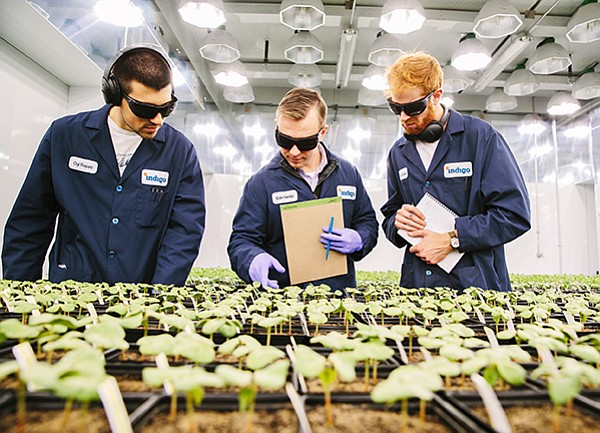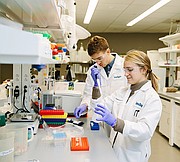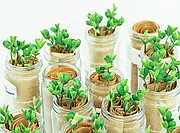HEALTHY COTTON CULTIVATION
The Natural Connection to Cotton-Seed Selection
The apparel and textile industries are under a lot of pressure these days.
Consumers are becoming more vocal about sustainability, where products are sourced and how they are made. Shoppers are more sensitive about the use of genetically modified organisms used in cotton production and often bristle at any mention of GMOs.
On top of this, insects and dry weather in California and Texas have inhibited cotton-crop production in these regions.
But a solution to some of these problems is being developed by Indigo Ag, a Boston-based company that has identified a natural, non-GMO approach to using microbes to ease the burden of problems associated with dependence on cotton-crop yields.
“We saw a 14 percent increase in [cotton] yield in water-stressed regions in our 2017 crop year,” said Elizabeth Fastiggi, Indigo Ag’s head of market development. “That was an increase over the 11 percent increase in yield that we saw the previous year.”
During its trials, Indigo Ag monitored the effect of its microbes on crop output in one of the hardest-hit cotton-producing regions—Texas.
“We are always expanding our acreage year over year and expanding to new regions and territories, but most of our cotton production is focused in states located in and around the Cotton Belt, including Texas, Georgia and Mississippi,” Fastiggi explained.
While the innovation found within the company’s solutions aid farmers in their quest for more consistent crop yields that help the apparel industry, Fastiggi emphasized that Indigo Ag’s core values monitor consumer behavior to calculate the market climate.
“We are building what we consider to be the first consumer-focused agriculture company,” she said. “It’s really looking at the shifting consumer preferences and their demand for healthier, more sustainably produced food and apparel and how that is changing the industries.”
Indigo Ag has laid a foundation based upon fortifying farmers’ profitability, expanding the reach of sustainable fiber resources, and ensuring agriculture and farming align with the trend in nontoxic, feel-good fibers driving consumer demand.
“Our model is really developing what we call demand-led agriculture as opposed to the system that we’ve had for the last 100 years,” Fastiggi noted. “This is more supply fed. We are looking at a demand-driven system. Our core mission statement is ‘harnessing nature to help farmers sustainably feed and clothe the planet.’”
The Indigo Ag approach to “harnessing nature” requires looking at plant compositions and examining the microbes that affect different biological processes. Due to modern agricultural methods of crop cultivation, the health and survival of these microbes could be threatened.
Using science, Indigo Ag has developed seed coatings comprising microbes that are most conducive to cultivating healthy plants. Comparing the treatment as “probiotics for plants,” Fastiggi explained how the health of certain microbes can promote efficient water use.
“We have a whole product portfolio of microbes that naturally occur in these plants, which we evaluate to [identify and] understand the microbes that can help with water-use efficiency,” she said. “This process makes plants more efficient in their water use, therefore making them use less water or allowing them to be grown on nonirrigated acres or rain-fed acres to decrease that pressure that we have on our freshwater resources.”
One issue that affected California cotton-crop yields last year was the threat of an insect known as the lygus. Many might use pesticides to rid their fields of the insect, but Indigo Ag advises that a better and more natural solution to hazardous pesticides exists.
“We also have microbial products in our pipeline that can make crops more resistant to pests and disease pressures, minimizing the need for chemical pesticides,” Fastiggi said.
In addition to decreasing the need for water and pesticides in cultivating cotton crops, Indio Ag cultivates a variety of different microbes to provide solutions for other crop issues.
When a healthy plant grows with a strong source of healthy microbes, the need for additional nutrients added by farmers—including synthetic nitrogen—will diminish.
The use of synthetic nitrogen has polluted more water sources, such as the infamous algae bloom seen in fresh water from New York to Oregon and along coastlines from Southern California to southwest Florida.
“Greenhouse-gas emissions associated with the production of synthetic nitrogen is very often overused in farming practices because historically it’s been difficult to understand how much was really needed,” Fastiggi said. “Nitrogen runoff has become a real issue throughout our country and around the world, polluting a number of waterways.”
Indigo Ag is not alone in its mission. It has partnered with the Better Cotton Initiative, whose goals for sustainable cotton production align with Indigo Ag’s mission to naturally improve cotton seeds from the ground up.
“U.S. Indigo Cotton will be produced in accordance with the Better Cotton standards system,” she said. “They take a very holistic approach to cotton production, covering three specific pillars of sustainability: environmental, social and economic. Indigo’s mission and the three pillars of farmer profitability, sustainability and better health are in close alignment.”
Though Fastiggi emphasizes the consumer-driven approach of Indigo Ag’s model, she explained that the solution is based in partnerships with agriculture professionals and the farmers who are growing these crops.
“The growth in product categories that are perceived as healthier or more sustainable has taken market share from a lot of the more conventional consumer products,” she said. “Some of them [farmers] don’t fully realize how they can tap into a more sustainable form of agriculture that can be done at scale. What we’re demonstrating and showing them is that we can deliver the crops they need with enhanced sustainability attributes, but we do it at scale and meet their supply needs.”

























